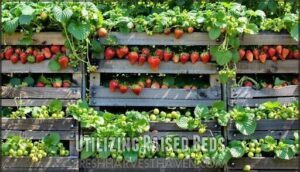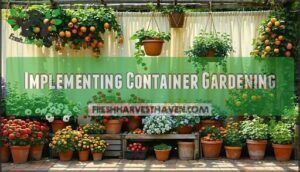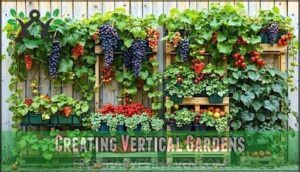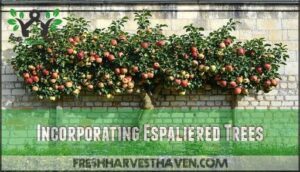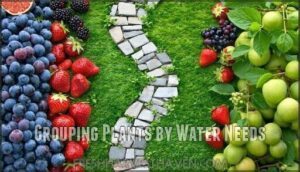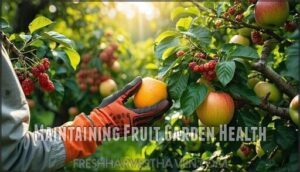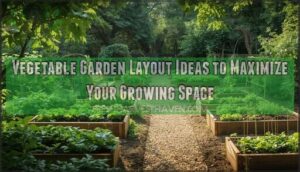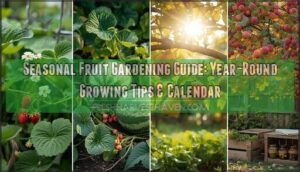This site is supported by our readers. We may earn a commission, at no cost to you, if you purchase through links.
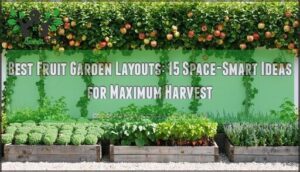
You’ll want to create zones based on plant height, water needs, and sunlight requirements – think tall fruit trees as your garden’s "backstage crew" providing shade for berry bushes below.
Vertical growing techniques like espalier trees and container stacking can triple your production in tight spaces, while raised beds improve drainage and soil control.
The secret lies in choosing the right mix of dwarf varieties, compact bushes, and climbing fruits that play well together like a perfectly choreographed garden symphony, with strategic plant placement.
Table Of Contents
- Key Takeaways
- Planning Fruit Gardens
- Space Optimization Techniques
- Fruit Garden Design Tips
- Climate Considerations Matter
- Maintaining Fruit Garden Health
- Frequently Asked Questions (FAQs)
- What makes a good fruit garden layout?
- How do you plan a backyard fruit garden?
- How do you create a fruit garden layout?
- What makes a good fruit garden?
- How to grow fruit in a small fruit garden?
- How do you choose a fruit tree?
- What fruits cannot be planted together?
- How do I design a fruit garden layout?
- How do I create a perfect fruit garden?
- What are the different layouts for vegetable gardens?
- Conclusion
Key Takeaways
- You’ll maximize harvest by grouping plants with similar water needs and using vertical techniques like espalier trees that can produce 40-70 pounds per tree while requiring only 18-24 inches of space.
- You can triple your production in small spaces by combining dwarf varieties, container gardening, and raised beds that provide better drainage and soil control for optimal growing conditions.
- You’ll create efficient layouts by planning zones based on plant height and sunlight requirements, positioning tall fruit trees to provide natural shade for berry bushes below.
- You’ll ensure long-term success by choosing climate-appropriate varieties for your hardiness zone and creating accessible pathways 3-4 feet wide for easy maintenance and harvesting.
Planning Fruit Gardens
Your fruit garden’s success starts with smart planning that matches your space, climate, and goals.
Choose varieties suited to your growing zone and group plants with similar needs to create an efficient, productive layout.
Choosing Fruits for Climate
When choosing fruits, matching climate zones makes all the difference between harvest success and disappointment. Your hardiness zones determine which varieties will actually thrive year after year.
Choosing climate-friendly fruits guarantees your garden thrives with healthy growth and delicious harvests year after year.
Consider these climate considerations for your fruit garden zone:
- Chill Hours: Apples need 700-1,000 hours below 45°F annually
- Frost Resistance: Hardy kiwis survive -30°F, citrus dies at 32°F
- Tropical Fruits: Mangoes require 11+ months of warmth above 50°F
- Microclimates: South-facing walls extend seasons by 2-3 weeks
- Regional Varieties: Local cultivars reduce disease by 25%
Smart fruit selection sets your garden layout up for maximum harvest success!
Selecting Suitable Garden Location
Your garden’s success starts with smart location scouting. Sunlight exposure matters most—fruit trees need six hours of direct sun daily.
Check soil drainage by digging a test hole after rain. Poor drainage solutions spell disaster for roots.
Water access should be within hose reach. Microclimate evaluation reveals wind patterns and frost pockets. Space assessment prevents overcrowding nightmares later.
| Location Factor | Good Choice | Poor Choice |
|---|---|---|
| Sunlight Exposure | South-facing slope | Shaded north side |
| Soil Condition | Well-draining loam | Clay that puddles |
| Water Needs | Near spigot/irrigation | Far from water source |
| Climate Considerations | Protected from wind | Exposed hilltop |
| Space Planning | Room for mature size | Cramped corners |
Assessing Soil Conditions
Your soil holds the secret to fruit garden success.
Test soil pH first—aim for 6.0-7.0 for ideal nutrient uptake. Check soil texture by squeezing moist earth; loamy soil benefits include perfect drainage and root penetration.
Improve poor drainage by adding organic matter like compost during soil preparation. Watch for nutrient deficiencies through leaf yellowing or stunted growth.
Good soil condition means healthier trees and bigger harvests down the road.
Determining Garden Size
Planning your fruit garden layout starts with realistic expectations about yield expectations and available space.
Don’t bite off more than you can chew—start small and grow your confidence along with your garden.
Consider these essential factors for effective fruit garden planning:
- Yield expectations: Calculate how much fruit your family actually consumes
- Available space: Measure sunny areas accurately for proper tree placement
- Future expansion: Reserve room for adding trees as your skills develop
- Maintenance level: Match garden size to your available weekend hours
- Time commitment: Factor in pruning, watering, and harvesting demands
Smart space optimization means planning for mature tree sizes now, not seedling dimensions.
Your small fruit garden will thank you later.
Space Optimization Techniques
Smart gardeners don’t let small spaces stop them from growing big harvests.
Determined gardeners transform tiny plots into fruit-producing powerhouses with clever design tricks.
You can pack more fruit into less space using four proven techniques that turn cramped yards into productive orchards.
Utilizing Raised Beds
Beyond the typical ground-level approach, raised beds transform your fruit garden design into a three-dimensional masterpiece.
These elevated growing spaces deliver superior drainage improvement while giving you complete soil control—no more battling clay or sandy disasters.
Perfect for small gardens, raised beds create accessible tiered plots that make harvesting a breeze.
Many gardeners find that prefabricated kits simplify the building process.
Raised Bed Element Details Benefits
This garden layout strategy also provides natural pest deterrence—slugs hate climbing walls!
Space optimization becomes effortless when you’re thinking vertically instead of just horizontally.
Implementing Container Gardening
Why settle for limited growing space when container gardening opens endless possibilities for your container fruit garden? Dwarf varieties thrive in pots, making container gardening perfect for patios and balconies.
Consider exploring compact tree options for your limited spaces.
Follow these mobility options for success:
- Choose containers matching root systems and container size requirements
- Use premium potting mix for ideal drainage and nutrition
- Match watering needs to pot dimensions and plant maturity
- Rotate containers seasonally for balanced sunlight exposure across your fruit garden layouts
Creating Vertical Gardens
Working with walls and fences opens up incredible opportunities for vertical fruit gardens.
Wall Trellises support climbing fruits like grapes, passionfruit, and hardy kiwis that’ll transform bare surfaces into productive spaces.
Hanging Baskets work perfectly for strawberries, while Pallet Gardens and Gutter Gardens create multi-level growing systems for herbs and smaller fruits.
Vertical towers maximize your harvest in minimal square footage.
This vertical growing approach turns neglected wall space into a living pantry that’s both beautiful and productive—you’ll wonder why you didn’t try it sooner!
Vertical gardening also improves airflow and plant health.
Incorporating Espaliered Trees
Why squeeze standard trees into tight spaces when espalier transforms them into living art?
This ancient technique trains fruit trees flat against walls or trellises, requiring just 18-24 inches of space while delivering impressive espaliered fruit yield.
Espaliered tree types like apples and pears excel with proper espaliered support systems using heavy-gauge wires spaced 12-18 inches apart.
Pruning espaliered trees monthly during growing season maintains twodimensional growth patterns.
These vertical fruit garden solutions need 6+ hours of direct sunlight daily to meet espaliered sunlight needs.
Your fruit tree pruning efforts create stunning focal points that produce 40-70 pounds per mature tree.
Fruit Garden Design Tips
Smart design transforms small spaces into productive fruit havens. You’ll maximize your harvest by positioning plants strategically and creating efficient maintenance systems that save time while boosting yields.
Designing for Sun Exposure
Start by mapping your garden’s daily sunlight patterns throughout the growing season. Sunlight mapping reveals prime spots receiving six to eight hours of direct sun.
Position sun-loving fruits like strawberries and citrus in these optimal zones. Consider shading effects from nearby structures and trees that shift with seasonal changes.
Smart sun planning accounts for your garden’s unique microclimate conditions, ensuring proper ideal placement for maximum fruit production.
Sunlight mapping is essential to identify the best golden hours available for fruit garden productivity.
Creating Pathways for Maintenance
Well-planned garden pathways transform your fruit garden into an efficient workspace.
Choose durable pathway materials like gravel or bark mulch for superior erosion control and longevity.
Here’s your pathway blueprint for easy navigation:
- Width matters: Make paths 3-4 feet wide for wheelbarrow access
- Strategic placement: Position main routes between tree rows for tool access
- Material selection: Use decomposed granite or wood chips for stability
- Edging stones: Install borders to contain materials and define walkways
- Irrigation access: Run water lines alongside paths for convenient sprinkler systems
Smart efficient garden layout means reaching every tree without trampling soil or struggling with equipment.
Grouping Plants by Water Needs
Once you’ve created pathways, it’s time to organize plants by their thirst levels. Grouping plants with similar water needs creates hydrozoning benefits that’ll make your life easier.
Drought tolerant fruit like figs and pomegranates go in well-drained areas, while thirsty berries prefer spots with better moisture retention.
| Low Water Zone | High Water Zone |
|---|---|
| Figs, Pomegranates | Strawberries, Raspberries |
| Grapes, Olives | Blueberries, Blackberries |
| Prickly Pear | Elderberries, Currants |
This moisture zoning approach boosts irrigation efficiency while promoting water conservation. You’ll install irrigation systems that match each zone’s drought tolerance needs perfectly.
Using Fruit Garden Planner Tools
With garden planning tools, you’ll transform chaotic fruit plots into organized harvests.
These digital assistants offer layout visualization and spacing adjustments that prevent overcrowding disasters.
- Design customization features let you arrange trees by sun exposure and water needs
- Software comparisons help you choose between free apps and premium platforms
- Feature prioritization guides focus on essential tools like climate mapping
- Garden layout ideas generate automatically based on your space dimensions
- Tool comparisons reveal which planners offer the best spacing calculators
Many gardeners find the fruit garden planner particularly helpful.
Modern garden planning beats guesswork every time.
Climate Considerations Matter
Your fruit choices need to match your local weather patterns, or you’ll end up with expensive compost instead of a harvest.
Smart climate planning means picking varieties that actually thrive in your area’s temperature swings, rainfall, and seasonal patterns, which is crucial for a successful harvest.
Understanding Local Climate Conditions
Before diving into climate specifics, recognize that microclimate awareness transforms ordinary gardeners into weatherwise gardening experts.
Your backyard isn’t uniform—it’s a patchwork of mini-environments. The use of mulch for insulation can substantially aid in protecting plants.
| Climate Factor | Garden Impact |
|---|---|
| Hardiness Zones | Determines winter survival rates |
| Chill Hours | Controls fruit production timing |
| Rainfall Patterns | Affects irrigation and disease risk |
Understanding microclimate effects means noticing that south-facing walls create heat pockets while low spots collect frost. Regional varieties thrive because they’ve adapted to local conditions over generations.
Selecting Climate-Appropriate Fruits
Your climate zone determines which fruits will thrive versus struggle in your garden. Regional varieties offer built-in frost resistance and disease tolerance for your area.
Microclimates in your yard can extend growing possibilities beyond your zone’s limits. Selecting varieties with disease-resistant qualities can reduce the need for chemical treatments.
- Match chill hours requirements (300-1,200 hours below 45°F) for temperate fruits like apples and peaches
- Choose tropical fruits like citrus or avocados only in frost-free zones 9-11
- Select climatefriendly fruits with plant hardiness ratings matching your specific zone’s temperature extremes
Preparing for Extreme Weather
You can’t control Mother Nature, but you can outsmart her tantrums.
Build frost protection using row covers or frost blankets when temperatures drop. Install windbreaks like hedges or fencing for wind mitigation. Create proper drainage solutions to prevent waterlogged roots during heavy rains.
| Weather Challenge | Protection Method |
|---|---|
| Spring Frost | Row covers, frost cloths |
| Strong Winds | Windbreaks, tree stakes |
| Heavy Rain | Raised beds, French drains |
| Summer Heat | Shade cloth, mulching |
Choose drought-tolerant varieties and climate-friendly fruits for your region’s specific challenges.
Protecting From Frost and Wind
When winter arrives like an uninvited guest, you’ll need smart strategies to protect your fruit garden from frost and wind damage.
Proper Windbreak Placement and Microclimate Creation act like a cozy blanket for your plants.
- Install frost blankets during cold snaps to shield tender varieties from freezing temperatures
- Plant strategic windbreaks using evergreen hedges to block harsh winds and create warmer microclimates
- Choose frost-resistant varieties and avoid planting in frost pockets where cold air settles
Maintaining Fruit Garden Health
Once you’ve created your perfect fruit garden layout, keeping it healthy requires consistent attention to soil, plant inspection, and proper care practices.
Your garden’s long-term success depends on regular maintenance that prevents problems before they start and guarantees your plants produce the best possible harvest year after year.
Soil Preparation and Maintenance
Strong soil health starts with Soil pH Testing—aim for 6.0-7.0 for happy roots.
Mix in Organic Amendments like compost and aged manure before planting.
Poor Drainage Improvement? Add organic matter or install drainage tiles.
Mulch Application with straw or bark chips locks moisture in while keeping weeds out.
Smart Weed Control means less competition for nutrients.
Regular fertilizing with organic composts feeds your plants naturally.
Choose mulch types that suit your climate—wood chips last longer in dry areas.
Regular Garden Inspection
Since routine garden inspection serves as your first line of defense against problems, you’ll catch pest identification issues and disease prevention opportunities before they spiral out of control.
Regular monitoring keeps your fruit garden layouts thriving with minimal intervention.
- Pest Identification: Check leaves weekly for holes, sticky residue, or tiny crawling visitors
- Disease Prevention: Spot unusual leaf spots, wilting, or fungal growth early
- Growth Monitoring: Watch for yellowing leaves or stunted growth indicating deficiency symptoms
Proper Harvesting Techniques
When you notice those telltale ripeness indicators like perfect color and sweet fragrance, it’s time to harvest.
Use proper harvesting tools and gentle handling techniques to preserve quality.
Staggering harvest guarantees peak freshness while smart storage methods maximize your bounty’s lifespan.
| Fruit Type | Ripeness Signs | Best Tools |
|---|---|---|
| Apples | Firm, bright color, easy stem removal | Picking basket, pruning shears |
| Berries | Deep color, slight softness, sweet aroma | Shallow containers, fingertips |
| Stone Fruits | Slight give when pressed, fragrant | Soft-lined bucket, gentle twist |
Managing Pests and Diseases
Success in pest management relies on smart strategies that protect your harvest before problems escalate.
Organic Controls and Disease Prevention work better than reactive treatments. Regular Pest Identification helps you spot trouble early, while strategic Pruning Impact improves airflow to prevent fungal diseases. Seasonal Management timing makes all the difference.
To further protect your fruit trees, consider companion planting strategies with pest-repelling plants.
- Use organic pesticides like neem oil and beneficial insects for natural pest control fruit gardens
- Install fruit fly management traps and remove fallen fruit to break pest lifecycles
- Apply approved fruit pesticides only when monitoring shows economic thresholds are reached
Fertilizing and Mulching Strategies
Why wait for store-bought fruit tree fertilizer when you can create nutrient-rich soil amendments right at home?
Your fruit garden thrives when you combine smart fertilizing strategies with proper mulching techniques.
Here’s your path to garden success:
- Feed your trees organic fertilizers like compost in early spring when buds swell
- Layer organic mulches such as wood chips around trees, keeping mulch away from trunks
- Monitor for nutrient deficiencies through leaf yellowing or poor fruit development
Composting methods transform kitchen scraps into garden gold, while mulch types like straw retain moisture and suppress weeds.
Frequently Asked Questions (FAQs)
What makes a good fruit garden layout?
You’ll create a winning fruit garden by grouping plants with similar water needs, ensuring proper spacing for airflow.
This approach also involves placing sun-loving fruits in areas with 6-8 hours of daily sunlight for maximum yields.
How do you plan a backyard fruit garden?
Want to turn your backyard into a fruit paradise? Start by evaluating your space, testing soil pH, selecting climate-appropriate varieties, and designing pathways for easy maintenance access.
How do you create a fruit garden layout?
Design your layout by testing soil pH, measuring sunny spots, and spacing trees properly.
Group plants with similar water needs together.
Use dwarf varieties for small spaces, create clear pathways, and consider vertical growing options.
What makes a good fruit garden?
Expensive doesn’t always mean impossible – you’ll discover that smart planning beats big budgets.
Choose climate-appropriate fruits, make certain of proper sunlight and drainage, group plants by water needs, and start small with easy varieties.
How to grow fruit in a small fruit garden?
Use containers with dwarf varieties and quality potting mix. Try vertical growing with trellises for grapes or kiwi. Espalier trees against walls saves space while adding beauty.
How do you choose a fruit tree?
Consider your climate zone, available space, and maintenance preferences. Choose disease-resistant varieties suited to your region’s chill hours and soil conditions. Pick self-fertile trees or plan for cross-pollination partners.
What fruits cannot be planted together?
Think of your garden as a school cafeteria—apples and walnuts don’t mix well, citrus and stone fruits argue over space, and blackberries bully raspberries.
Group fruits with similar needs, or you’ll have drama in the dirt, with complete concepts of garden management in mind.
How do I design a fruit garden layout?
Start by choosing a sunny spot with good drainage, then group plants by water needs.
Plan pathways for easy access and space dwarf trees 8-10 feet apart, standard trees 15-25 feet apart for ideal growth.
How do I create a perfect fruit garden?
Perfect fruit gardens start with choosing climate-suited varieties and testing soil pH.
Plan sunny locations with proper drainage, space trees correctly, and group plants by water needs.
Add mulch, establish irrigation, and maintain through regular pruning for maximum yields.
What are the different layouts for vegetable gardens?
Vegetable gardens work best with row layouts, raised beds, square foot grids, or container setups.
You’ll choose based on your space, soil, and maintenance preferences—each offers unique advantages for different growing situations, making complete concepts essential for a successful garden.
Conclusion
Remember the old saying: "Good things come in small packages" – and your fruit garden proves this perfectly.
Successfully implementing the best fruit garden layouts transforms even tiny spaces into productive harvests.
You’ve learned to maximize vertical space, choose dwarf varieties, and create efficient zones that work together seamlessly.
Your strategic plant placement will reward you with abundant fruit while keeping maintenance simple.
Start small, think vertically, and watch your compact garden flourish beyond expectations.
- https://everglades.farm/blogs/news/how-to-choose-full-size-fruit-trees-for-your-garden
- https://www.xroci.com/blogs/xroci-guide-and-tips/dont-let-the-cold-stop-you-top-10-best-fruit-trees-for-cold-climates
- https://homesteadandchill.com/how-to-choose-fruit-trees/
- https://theamericanfigcompany.com/blogs/news/cultivating-diversity-10-cold-hardy-fruit-trees-for-your-garden
- https://www.cabidigitallibrary.org/doi/pdf/10.5555/20103342967

